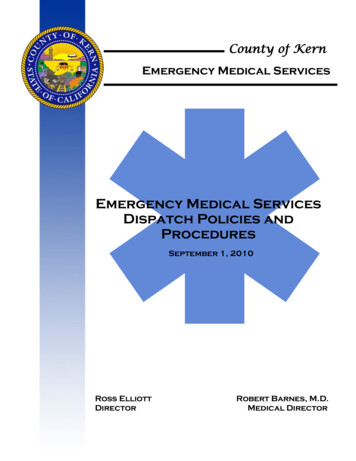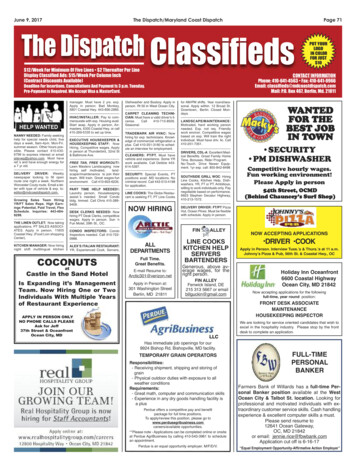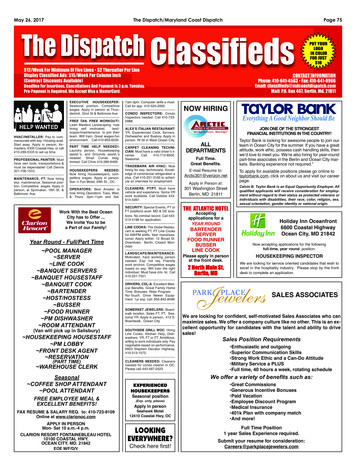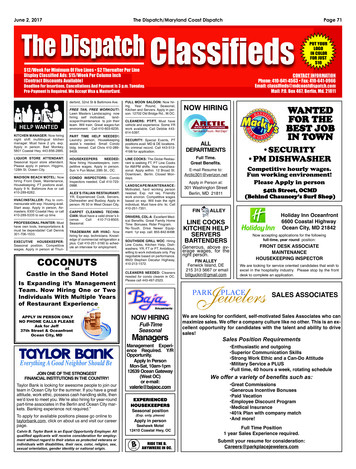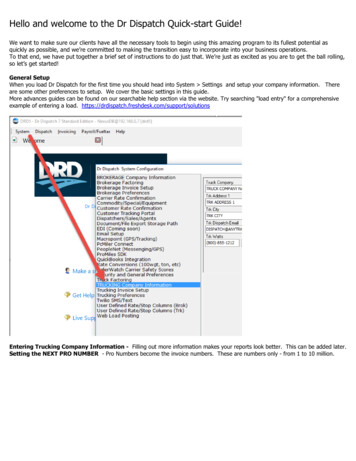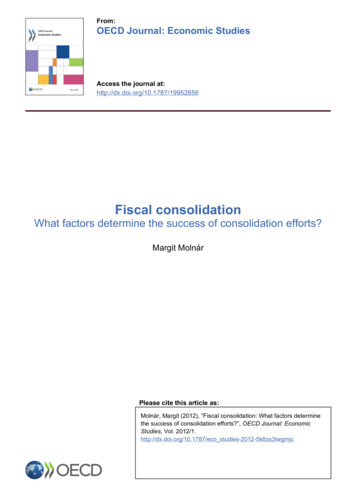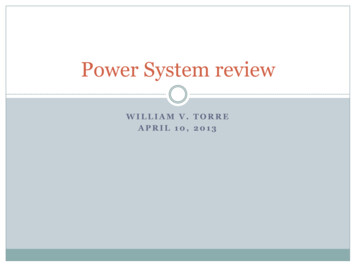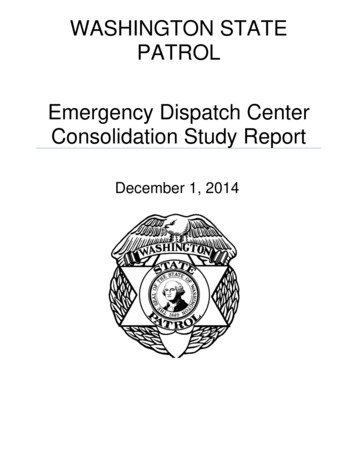
Transcription
WASHINGTON STATEPATROLEmergency Dispatch CenterConsolidation Study ReportDecember 1, 2014
Table of Contents1. Introduction22. Purpose23. Executive Summary24. Background35. Process56. Out of State Dispatch Center Consolidation Study Findings67. Other Organizations Consolidation Study Findings78. Washington State Agency Communication Consolidation Research89. Conclusion910. AppendicesAppendix A: CharterAppendix B: Communications Division Organizational ChartAppendix C: Yakima/Wenatchee/Spokane Consolidation SurveyAppendix D: Marysville/Bellevue Consolidation SurveyAppendix E: Tacoma/Vancouver/Bremerton Consolidation SurveyAppendix F: Construction CostsAppendix G: Current WSP Customers and Services ProvidedAppendix H: Washington State Patrol District MapAppendix I: State Consolidation Study - Idaho State PoliceAppendix J: State Consolidation Study - California Highway PatrolAppendix K: State Consolidation Study - Oregon State PoliceAppendix L: Oregon State Police Memorandum (October 2002)Appendix M:Consolidation Studies – King County E-911 Program OfficeAppendix N: Consolidation Study – Yakima County Sheriff’s Office (YSO)Appendix O: Consolidation Studies – Ferry County Sheriff’s Office (FCSO) &Southeast Communications (SECOM)Appendix P: Washington State Business Analysis:Evaluation of Consolidation of WSP/WSDOT Wireless CommunicationsSystems and OperationsPage 1
Introduction:This report is intended to present research and recommendations with regard to potentialefficiencies, savings and benefits of consolidating law enforcement and emergencydispatching centers.As part of this study, the Washington State Patrol (WSP) will look for potential efficiencieswithin state government. The study will include our current WSP statewideCommunication Centers eight (8), and other state agencies we dispatch for, such asDepartment of Natural Resources (DNR), Department of Fish and Wildlife (DFW), etc.,and include the emergency component of the Washington State Department ofTransportation (WSDOT) Incident Response Team (IRT). The WSP will also reviewrecent consolidation studies by the state police in Idaho, Oregon, and California, andreport on significant findings from those state agencies.Purpose:To work with the State Interoperability Executive Committee (SIEC) to compile a list ofrecent studies evaluating the potential savings and benefits of consolidating lawenforcement and emergency dispatch centers, and specifically look for efficiencies in stategovernment and report findings and recommendations to the Joint TransportationCommittee by December 1, 2014.Executive Summary:Further consolidation of the current Washington State Patrol Communications Divisionresources creates a risk of failure and increases overall expenses for equipment, facility,and operating costs by creating additional layers of management. Budget constraints andthe push for increased efficiency are prompting State Government as well as the privatesector to pursue consolidation more aggressively. However, Washington State Patrolbeing a leader in this effort had already consolidated from 27 communications centers in1983 to the existing eight (8) district headquarters communications centers by 1993. Thiswas a significant consolidation effort. The information contained within this report showsthat it will cost nearly 32 million dollars to further consolidate the WSP CommunicationsCenters, with no realized savings. Further consolidation effort would cause a loss ofcommand and control, and diminish the quality of services provided to the people, officers,and surrounding agencies.Page 2
Background:9-1-1 public safety communications personnel work closely with local law enforcement,fire, and emergency medical services. 9-1-1 is the gateway through which virtually everyemergency is reported, resulting in communications center personnel being the first toassist citizens in their time of need while simultaneously dispatching appropriate resourcesto the troopers and other agencies/personnel in the field.The first Washington State Patrol (WSP) communications center was established in 1943,located in Olympia. Prior to that, state patrolmen received their orders and broadcastinformation from local sheriffs’ offices, police departments or highway departmentinstallations. In the years that followed, 21 communications centers would be establishedstatewide. The WSP set up its own VHF microwave communications network, completingthe installation of two-way sets in all vehicles in 1943.Communications Officers (COs) wore a unique badge with a radio tower and a uniqueshoulder patch on their uniforms in the 1950s until the early 1970s when they transitionedto the current badge and the standard WSP shoulder patch. In 1983, an entirely newWACIC (Washington Crime Information Center) data base was brought on-line, providingfaster response time as well as access to the FBI's National Crime Information Centercomputer system and direct entry of missing persons and runaway children.For reasons of improved efficiency and reduced costs, the State Patrol consolidated from27 communications centers down to nine (9) and finally to what is now our currentstructure of eight (8) centers statewide co-located with their district headquarters. Theyare Bellevue (D2), Bremerton (D8), Marysville (D7), Spokane (D4), Tacoma (D1),Vancouver (D5), Wenatchee (D6) and Yakima (D3). (Note: The last center to consolidatewas the Olympia Center in 1993 when it was merged with Tacoma).The first step of this consolidation began on October 18, 1982. By the end of December1983, seven (7) of the now existing eight (8) districts were completely consolidated. As aresult of this consolidation effort, the WSP was able to reduce its full-time employee (FTE)count by 15 people statewide. However, the cost of upgrading equipment outweighed thesavings of those FTEs.WSP-Everett Communications Center 1978Page 3
Today the Communications Division headquarters, located in Olympia, under theTechnical Services Bureau, is led by a civilian special deputy Division Commander with six(6) total staff (Assistant Division Commander, Division Secretary and three (3)Communications Officers (see Appendix B). The division has 167 authorized positionscomprised of five (5) job classifications - Communications Officer Assistant (9-1-1 callreceiver), Communications Officer 1 (9-1-1 call receiver/dispatcher), CommunicationsOfficer 2 (call taker/dispatcher/trainer/lead worker or assistant training officer),Communications Officer 3 (shift supervisor or training supervisor) and CommunicationsOfficer 4 (communications center manager or division training program manager).Prior to 1986, communications centers used a punch card system to time stamp cards andhand write comments about incidents and unit locations. Daily reports were preparedusing typewriters.In 1987, the WSP created its first, “in house” Computer Aided Dispatch (CAD) system thatwas used until 2003. Communications Officers transmit, receive, and relay informationconcerning public safety and law enforcement activities to, from, and between State Patrolmobile units and stations, other state, county, city, and federal law enforcement agencies,and the public by means of radio, 9-1-1/business multiline telephone systems, and othertelecommunications devices. All of this information is entered, recorded and stored bymeans of a CAD system.The WSP gained international recognition for its development of the Mobile ComputerNetwork (MCN), an innovative system linking laptop computers in patrol cars with satelliteand land-based radio communication technology. The MCN became operational in 1991.In the late 1990s, Communications Officers transitioned from the typical Trooper uniformsto unique uniforms only worn by Communications Officers.In July 2003, the Communications Division procured a completely new CAD, Premier CADfrom Motorola, for all eight (8) centers. This 1.6 million project enabled the agency tohave a faster more efficient and effective CAD system with the expanded capabilities forcollecting data, providing numerous reports, integrating with 9-1-1 and displayingcomputerized maps of interstates, state routes and other roads state wide. It also had thepotential for interfacing with future technological advances (i.e., mobile laptop computers,automatic vehicle location, etc.). The system was upgraded in June 2008.Throughout our proud history until today, everyone in the Communications Division hasand will focus on officer and public safety. We provide a vital function as the “first of thefirst responders”, linking the emergency call to the emergency response 24 hours a day,every single day.Page 4
Process:The WSP contacted all of the Public Safety Answering Points (PSAPs), Sheriff’s Offices,and Police Departments; and identified any and all communications consolidation studiesconducted within the last five (5) years and it was identified that the following studies existin the State of Washington:(D1) South Sound 9-1-1 - Pierce Co (SS911) Voter initiative - no studyimplemented(D2) King County E9-1-1 Program Office, Marlys Davis - not implemented(D3) SUNCOM/YSO (Yakima Co), Wayne Wantland & Bob Udell - in planningstages(D3) FCSO/SECOM (Benton/Franklin Co), Ed Bush & Jim Barber - notimplemented(D8) JEFCOM (Jefferson Co) Karl Hatton - study being conducted(D8) PENCOM (Clallam Co) Steve Romberg - study being conductedIn addition, the WSP contacted neighboring states to collect any communicationsconsolidation studies that existed.The WSP also conducted a review of its communications centers and services provided toconduct a cost benefit analysis of any potential further consolidation of WSP facilities intothree (3) centers which were identified as ideal locations based on geographical area,current infrastructure, etc.; if the WSP were to further consolidate the current centers. Thelocations identified would be:1. Tacoma2. Marysville3. YakimaThe locations were identified to provide two (2) locations on the Westside (one (1) Northand one (1) South), and one (1) on the Eastside; for redundancy, labor pools, siteconsiderations, and retention.NOTE: All information contained within is with consideration of consolidating to thosethree (3) locations.A copy of all of the information received from each of these studies/surveys is included inthe appendices of this document and summarized within this report.Page 5
Out of State Dispatch Center Consolidation Study Findings:In July 2013, the Washington State Patrol conducted a survey of state police agencies inIdaho, Oregon, and California and identified consolidation studies they have conductedwithin the last five (5) years. The detailed information as provided in the appendix issummarized below:1) Idaho:Consolidated in 1997 from six (6) centers to three (3) centersConsolidated in 2009 from three (3) centers to two (2) centers2) Oregon:Consolidated 1993 from 26 centers to four (4) centersConsolidated in 2003 from four (4) centers to two (2) centers3) California: The California study provided includes consolidation ofcommunications centers as part of a consolidation of state agencies which includedthe California State Police (CSP) and the California Highway Patrol (CHP). Thismerger took place in 1995, and combined 271 CSP officers and 5,713 CHPofficers. The 68 non-uniformed employees of the CSP transferred to existing civilservice classifications, with the exception of CSP's Communications Operators whowere assimilated into the CHP's Communications Operator II classification. The269 remaining non-uniformed personnel changed to the new CHP classificationsestablished specifically for the consolidation. CSP and CHP were consolidatedfrom 40 to 25 dispatch centers throughout the state (five (5) of which areconsidered primary’s).4) Washington: Consolidated 1983 from 27 centers to nine (9), then again in the1990s down to the current eight (8) centers.StateIdahoOregonCaliforniaWashingtonState Land PopulationState(squareper 1NumberofDispatchCenters22248Numberof RadioUsers6466228,0002,688Number 1:16* Data provided based on US Census data from 2010.Number of Radio Users for WSP includes 19 contract agencies that we currently dispatchfor (such as WDFW for example). All other agencies listed above also include the numberof other agencies that they currently dispatch for.WSP dispatcher to radio user/officer ratio is currently in line with the other agencies listedabove without further consolidation efforts or considerations.Common benefits for consolidation of communications centers included, less equipmentand common CAD.Page 6
Common lessons learned by all consolidations included the loss of qualified personneldue to relocation which caused ongoing hiring and training issues across the state. Inaddition, there was a loss in geographic knowledge which influenced the ability fordispatch centers to provide the personal touch to callers and officers in their respectiveareas as it is more difficult for a dispatcher to “know the beat” when they are in charge ofdispatching for half of the state vs. having a smaller subset of counties.In addition, it was noted that radio coverage limitations must be taken into consideration toensure that a decrease in centers won’t impact service. Similarly, there must beredundancy within the system to ensure that if one center goes down, the other canhandle the calls (centers should not share a fault line).Other Organizations Consolidation Study Findings:WSDOT - In 1993 a study was conducted by WSDOT to work to best consolidate theservices of their Traffic Management Centers (TMC), and they partnered with WSP towork out incidents and reporting mechanisms in each of the districts. WSDOT currentlyhas six (6) regions across the state, and offers traffic management services 24 hours perday, 7 days per week (24/7). Typically, there are seven (7) radio operators on duty acrossthe state during business hours. Incident response is handled by the WSDOT IncidentResponse Group that typically handles approximately 4,500 incidents per year. In 2011,an evaluation of consolidating WSP/WSDOT wireless communications systems(infrastructure) was commissioned by WSDOT.WDFW - Reported that they have not done an official consolidation study with regard todispatch services.Page 7
Washington State Agency Communication Consolidation Research:Per a March 2012, “Public Safety Communications” article put out by APCO (pg. 58), itstates in part that “The latest addition to the National Fire Protection Association (NFPA)standard for Communications Centers, NFPA 1221 Standard for the InstallationMaintenance, and use of Emergency Services Communications Systems, 2010 edition,made it fairly clear what constitutes a Communications Center and what is required toincorporate these facilities into other facilities such as police headquarters. TheCommunications Center, under these rules and generally accepted practice; needs to beseparated from any other space within the facility by a two (2) hour fire separation. Thiszone should include the immediate staff office and support spaces, such as break rooms,wash rooms, and locker areas. The required two (2) hour separation applies to the floorand ceiling areas as well. In addition, there is a need to provide ballistic protected glassfor any outside windows. The walls surrounding the dispatch center must also beprotected. As a last resort, the center must be able to “gracefully” shut down and transferoperations to a secondary Public Safety Answering Point (PSAP). The requirement for afull backup location is often mandated by local or provincial/state law and can be handledby service agreements with adjoining jurisdictions.” This article goes on in further detailabout these requirements that NFPA 1221 stipulates.With the premise of the WSP consolidating from eight (8) centers to three (3) centerslocated in Tacoma, Marysville, and Yakima; the WSP researched the potential cost,benefits and challenges for consolidation. The rationale behind selecting Marysville,Tacoma, and Yakima for the three (3) locations was based on location, population, currentcapacity, building and land availability, staffing levels, etc.Managers were asked to survey their current personnel and determine how many (byclassification) would be willing to relocate to retain their position with the CommunicationsDivision of WSP. Page 8District 4 (Spokane) – 12.5% willing to relocate. Two (2) have indicated theymay be willing to move in the future.District 6 (Wenatchee) – 53% willing to relocate.District 3 (Yakima) – 30% willing to relocate.District 5 (Vancouver) –Approximately 33% willing to relocate.District 8 (Bremerton) – Approximately 4% willing to relocate.District 2 (Bellevue) – Approximately 50% willing to relocate.
The WSP does not anticipate that a reduction in required staffing levels would occur if theagency consolidated from eight (8) to three (3) dispatch centers. The survey resultsindicated that the number of personnel would remain the same. The challenge would befilling the positions in the new locations, as many of the current staff indicated that theywould not be willing to re-locate. This is a challenge that other states found during theirconsolidations and continue to deal with through attrition and ongoing training issues.The following rough cost estimates were provided for the consolidation of the current eight(8) centers into the following three (3):CostLandFacilitiesComm. towerMicrowave hopsAdded StaffingAdded Mgmt.Recruit/TrainingTelephone equip.Leased data circ.VoIP data networkConsole positionsInfrastructureTotalYakima 329,300.00 3,663,000.00 175,000.00 180,000.00 287,196.00 5,000.00 2,394,522.00 592,990.15 45,600.00 250,000.00 1,200,000.00 267,359.76 9,389,967.91Marysville 2,500,000.00 3,515,000.00 175,000.00 180,000.00 391,716.00 70,000.00 2,394,522.00 529,427.24 45,600.00 250,000.00 1,080,000.00 267,359.76 11,398,625.00Tacoma 1,000,000.00 4,033,000.00 175,000.00 180,000.00 234,936.00 5,000.00 2,394,522.00 735,356.04 45,600.00 250,000.00 1,500,000.00 268,487.26 10,821,901.30Total: 31,610,494.21Conclusion:Consolidation Considerations: An increase in staffing numbers based on three (3) locations from reducedfrom eight (8).o Add 10 COAs, six (6) CO2s and create three (3) CO5s. Potential costs benefits by consolidating other agency’s dispatch (WSDOT,WDFW, and DNR) communications centers with the WSP communicationscenters.Page 9
Potential Challenges: Decrease in Service Quality - If we were to consolidate further from the currenteight (8) communications centers that we have statewide, we would likely see adecrease in services as follows:o Staff being unfamiliar with the area that they serve, there is likely to be anincrease in the length of response times.o With staff being unaware of the geographical area that they are serving, there isa likelihood that Communications Officers may struggle with calls for servicebased on the fact that they will not have the current familiarity with locallandmarks and other major indicators.o There is also an added likelihood that the Communications Division will havemore time focused on training of new staff, as the retention of our current staffwill be diminished due to their inability or unwillingness to relocate to the newfacility.o We currently struggle to hire qualified staff in the eight (8) districts that wecurrently serve. If the number of Communications Centers were decreased fromeight (8) to three (3), we would have less of a geographical area to hire from,thus decreasing our candidate pool by about 62% of the current hiring pool.o The ability to interact face to face with the district’s commanders, managers,and supervisors with whom we serve to maintain command and control. Thereare often many questions with regard to performance issues or policy directions,which are currently worked out because of our easy access. Availability and purchase of the land and building construction are estimated in thereport. These figures are based on county assessed values, and may be much higherat the time of purchase, and are dependent on actual availability. Obtaining this landmay prove to be problematic. WSP is currently converting from analog to P25 digital radio operations due to anunfunded Federal mandate. To begin conversion to consolidation to three (3) centerswould have a significant impact to radio coverage for officers, increased delay toimplementation, and unknown fiscal impacts. Reduced participation in weekly and monthly management meetings coordinatingenforcement efforts of Field Operations Bureau (FOB), investigations, weighing andinspections operations, and multi-agency efforts.After careful consideration and review of all other surrounding state’s dispatch studies, therecommendation would be not to continue with further consolidation of the current WSPCommunications Centers. Since the WSP has already consolidated CommunicationsCenters and resources (last done in 1993), further consolidation would create a risk offailure and increase the overall expenses for equipment, facility, and operating costs bycreating additional layers of management.Possible consolidation efforts to be explored would be to further consolidate stateagencies (such as eliminating duplication of effort by WDFW and possibly DNR andWSDOT) by looking for efficiencies within state government. This would include whetheror not consolidation of these dispatch centers would be more/less efficient since they arestate agencies that provide dispatch services.Page 10
Appendix AProject Charter InformationOrganizationSponsorMark Layhew, Communications Division CommanderProject ManagerMeagan Renick, Communications Division AssistantCommanderCore Project TeamMeagan RenickLaurie LangloisJo BaumgartnerJulie HudsonLaDonna BrowellRichard WarrenYvonne LeBlancAndrea MarlowMonte SimpsonDonna BarnesGoals and ObjectivesProject GoalStatementESSB 5024 requires the Washington State Patrol to work withthe State Interoperability Executive Committee (SIEC) tocompile a list of recent studies evaluating the potential savingsand benefits of consolidating law enforcement and emergencydispatch centers, and specifically look for efficiencies in stategovernment.Project Objectives TimeframeSummaryPage 11Develop scope of projectFinalize project charterMeet with key stakeholdersDivide work assignments among station managers; toinclude recent state police dispatch consolidation studies inOregon, Idaho, and CaliforniaDevelop a consolidated dispatch model for WSP andemergency dispatch centersEvaluate potential savings and benefitsLook for efficiencies in State GovernmentReview findings and recommendations with SIECPrepare final report for the Joint Transportation CommitteeQuarterly Update Meeting Dates:SEPTEMBERDECEMBERMARCHJUNESEPTEMBERDECEMBER 1st201320132014201420142014-DUE DATE
ProjectRequirementsRank scope, schedule, cost, and quality. Also describe anylimitations that require approval from the Sponsor.1Scope2Schedule3Cost4QualityMilestones and DeliverablesMajor MilestonesItemEst. DateDraft Scope to AC BerryJuly 8, 2013Draft Scope to SIECJuly 15, 2013Manager’s Meeting in District 4-SpokaneJuly 16, 2013Project Charter to SIECAugust 9, 2013Part 1 Reports due from ManagersAugust 16, 2013District Commander Meeting/InputOctober 1, 2013Consolidation Reports/Draft AnalysisOctober 1, 2013Reports for ID, OR and CA States Policeback from Training ManagerNovember 1,2013Part 2 Reports due from Managers on WSPconsolidationDecember 2,2013Draft Report for Transportation Committee toAC BerryApril 2, 2014Review by AC Berry completeMay 1, 2014AC Berry’s revisions completeJune 2, 2014Presentation to Executive StaffJuly 1, 2014Executive Staff comments incorporatedAugust 1, 2014Copy of Report to SIECAugust 4, 2014Examine the potential savings and benefits of consolidation andefficiencies within WSP. Report findings and recommendationsto the Joint Transportation Committee by December 1, 2014.Page 12
Major DeliverablesItemEst. DateProject Charter CompleteAugust 8, 2013Requirements CompleteJuly 15, 2014Management Plan CompleteAugust 1, 2014Schedule CompleteDecember 1,2014Scope (May require a separate document)Project ScopeWSP will work with SIEC to compile a list of recent (within thepast five (5) years) law enforcement and emergency dispatchingcenters consolidation studies, and evaluate the potential savingsand benefits thereof.As part of this study, the WSP will look for potential efficiencieswithin state government. The study will include our current eight(8) WSP Communication Centers, and other state agencies wedispatch for, such as DNR, DFW, etc., and include theemergency component of WSDOT (IRT). The WSP will alsoreview recent consolidation studies with the state police inIdaho, Oregon, and California, and report on significant findings.The WSP will report its findings to the Joint TransportationCommittee by December 1, 2014.Page 13
Appendix BCommunications Division Organizational ChartCommunications DivisionSeptember 2014Division AdministratorMark LayhewPosition #: E145Administrative Assistant 3Shirley MottPosition #: 0100Division Assistant AdministratorMeagan K. RenickPosition#: 0152Training Program ManagerDonna M. BarnesPosition #: 0004Training Program SupervisorCO 3 Mary E. RansierPosition #: 0869D1 CommMgrCO 4LaurieLangloisPosition #:0850D2 CommMgrCO 4JoBaumgartnerPosition #:0587Page 14D3 CommMgrCO 4Julie HudsonPosition #:0870D4 CommMgrCO 4YvonneLeBlancPosition #:0875D5 CommMgrCO 4CherylOltmannPosition #:0865CAD Systems AdministratorActing ITS 4 Richard WarrenPosition#: 1654Training Program OfficerCO 2 Jonathon W. LerewPosition #: 0857D6 CommMgrCO 4TonyAmoratiPosition#: 0874D7 CommMgrCO 4AndreaMarlowPosition#:0143D8 CommMgrCO 4MonteSimpsonPosition #:0135
Appendix CYakima/Wenatchee/Spokane Consolidation Survey1. For the Yakima (Yakima (District 3)/Spokane (District 4)/Wenatchee (District 6))Communications Center, determine the staffing needs by classification to cover thecurrent workload for Yakima, Spokane, and Wenatchee. Compare the consolidatedstaffing level to the current staffing level of all three (3) centers.Staffing Level By District:1. Yakima current – 15, consolidated – 162. Spokane current – 16, consolidated – 173. Wenatchee current – 16, consolidated – 17Total Positions – 47, Consolidated Total – 50Broken Down as follows:o District 4 current staffing is 16 – Consolidated Center 17 (12.5% willing torelocate).o District 6 current staffing is 16 – Consolidated Center 17 (53% willing torelocate).o District three (3) Current staffing is at 15 – Consolidated Center 16.o Add three Communications Officer Assistant (COA) positions to help handlephones during peak periods (especially if there are added users under theconsolidated model).2. For the Yakima consolidated center, determine how many call positions/consoleswould be needed for the communications center. Compare to current level in all three(3) centers.New Staffing Level Assumptions: Building would have to accommodate additional staffing through 2040, as 9-1-1 callsand texting will increase the number of positions needed to cover incoming calls. Would require one (1) communications center manager (CO5) and two (2) assistantmanagers (CO4’s - day shift/night shift) – Which includes a manager to oversee overalloperations and supply budget/ordering of supplies and serve as a direct contact fordistrict commanders with two (2) assistant managers to oversee all personnel and dayto day running of the center including customer service, liaison to outside useragencies, and scheduling. This is a net gain of one (1) management position. Would require the same number of Communications Officer 3 (CO3)-Supervisors six(6), One (1) for every eight (8) employees to supervise day to day operations andcomplete employee performance evaluations. Would require same number of Communications Officer 2 (CO2)-LeadOperator/Trainer positions. To accomplish this, the agency anticipates a need totemporarily elevate four Communications Officer 1 (CO/CO1) positions to CO2positions, if center was located in Yakima, since a majority of the pre-existing CO’s inD4 and D6 would not be willing to move. Would require same as current staffing number of CO1 positions with the addition ofthree (3) Communications Officer Assistant (COA) Call Taker positions, one (1) perdistrict, to assist with the increased geographical area that they are covering.Page 15
3. For the Yakima consolidated center, determine how may additional positions WSPwould want for future growth, to the year 2040, and how many positions WSP wouldwant to dedicate as back-up positions for other centers in the area. Moving the communications center to a consolidated center in Yakima wouldrequire continuous training of new COs, since the majority of existing COsfrom Spokane and Wenatchee would not move. This may create the needfor at least six (6) additional CO2-trainer positions.Recruitment & training costs for one (1) center 2,394,522.00.4. For the consolidated center, determine the estimated square footage per position,square footage of manager’s office, supervisor’s office, restrooms, conference room,quiet room, testing room, training room, etc. Total number of consoles: 20 @ 400 sq. ft. 8,000 sq. ft. Command/conference room 1,000 sq. ft. Reception area 1,000 sq. ft. Reception area restrooms 2 @ 600 sq. ft. 1,200 sq. ft. Training/testing room 1,000 sq. ft. Counseling/Quiet room 300 sq. ft. Command radio console 200 sq. ft. Manager’s office 400 sq. ft. Assistant manager’s office 400 sq. ft. x 2 800 sq. ft. Supervisor’s cubicles: 6 @ 200 sq. ft. 1,200 sq. ft. Restrooms (men/women) 600 sq. ft. ea. 1,200 sq. ft. Kitchen/break roo
Out of State Dispatch Center Consolidation Study Findings 6 7. Other Organizations Consolidation Study Findings 7 8. . (Washington Crime Information Center) data base was brought on-line, providing . Common benefits for consolidation of communications centers included, less equipment and common CAD.
